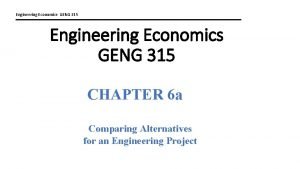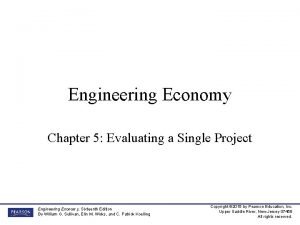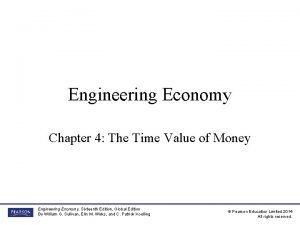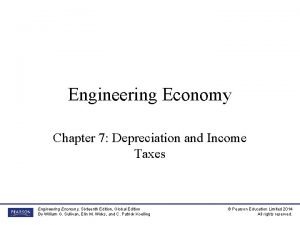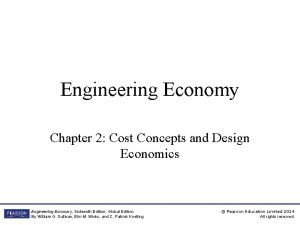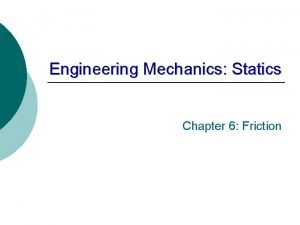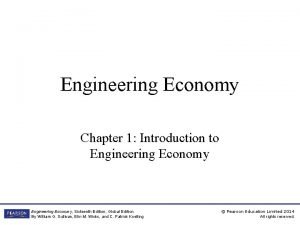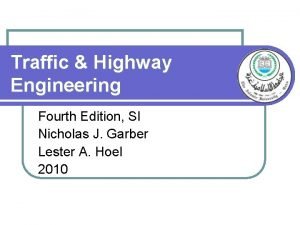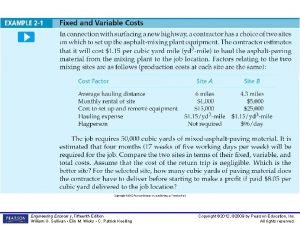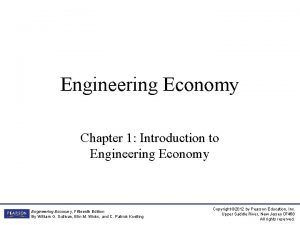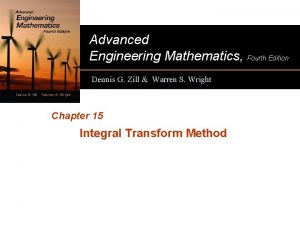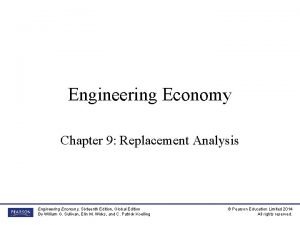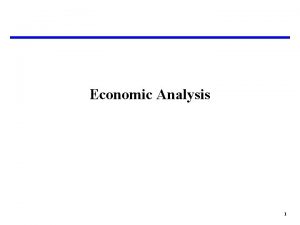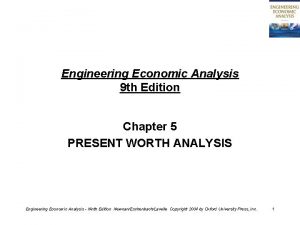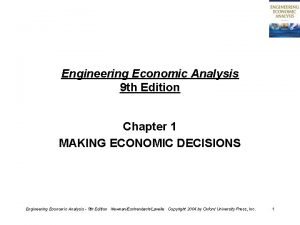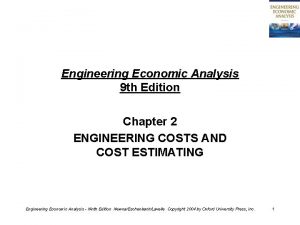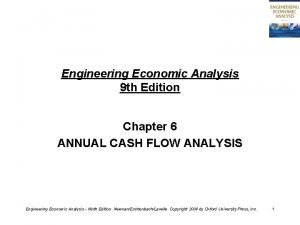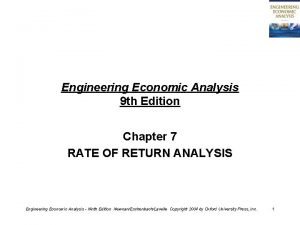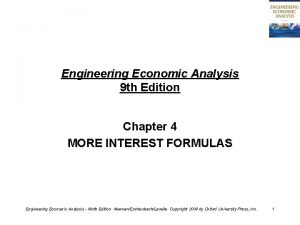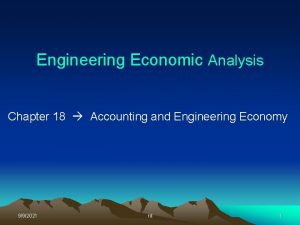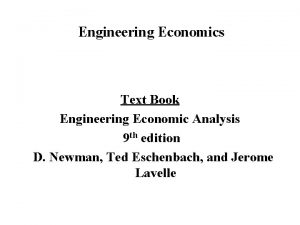Engineering Economic Analysis 9 th Edition Chapter 3






















- Slides: 22

Engineering Economic Analysis 9 th Edition Chapter 3 INTEREST AND EQUIVALENCE Engineering Economic Analysis - Ninth Edition Newnan/Eschenbach/Lavelle Copyright 2004 by Oxford Unversity Press, Inc. 1

Economic Decision Components • Where economic decisions are immediate we need to consider: • amount of expenditure • taxes • Where economic decisions occur over a considerable period of time we also need to consider: • interest • inflation Engineering Economic Analysis - Ninth Edition Newnan/Eschenbach/Lavelle Copyright 2004 by Oxford Unversity Press, Inc. 2

Computing Cash Flows • Cash flows have: • Costs (disbursements) > a negative number • Benefits (receipts) > a positive number Example 3 -1 Engineering Economic Analysis - Ninth Edition Newnan/Eschenbach/Lavelle Copyright 2004 by Oxford Unversity Press, Inc. 3

Time Value of Money • Money has value • Money can be leased or rented • The payment is called interest • If you put $100 in a bank at 9% interest for one time period you will receive back your original $100 plus $9 Original amount to be returned = $100 Interest to be returned = $100 x. 09 = $9 Engineering Economic Analysis - Ninth Edition Newnan/Eschenbach/Lavelle Copyright 2004 by Oxford Unversity Press, Inc. 4

Simple Interest • Interest that is computed only on the original sum or principal • Total interest earned = I = P x i x n • Where • P – present sum of money • i – interest rate • n – number of periods (years) I = $100 x. 09/period x 2 periods = $18 Engineering Economic Analysis - Ninth Edition Newnan/Eschenbach/Lavelle Copyright 2004 by Oxford Unversity Press, Inc. 5

Future Value of a Loan with Simple Interest • Amount of money due at the end of a loan • F = P + P i n or F = P (1 + i n ) • Where • F = future value F = $100 (1 +. 09 x 2) = $118 • Would you accept payment with simple interest terms? • Would a bank? Engineering Economic Analysis - Ninth Edition Newnan/Eschenbach/Lavelle Copyright 2004 by Oxford Unversity Press, Inc. 6

Compound Interest • Interest that is computed on the original unpaid debt and the unpaid interest • Total interest earned = In = P (1+i)n - P • Where • P – present sum of money • i – interest rate • n – number of periods (years) I 2 = $100 x (1+. 09)2 - $100 = $18. 81 Engineering Economic Analysis - Ninth Edition Newnan/Eschenbach/Lavelle Copyright 2004 by Oxford Unversity Press, Inc. 7

Future Value of a Loan with Compound Interest • Amount of money due at the end of a loan • F = P(1+i)1(1+i)2…. . (1+i)n or F = P (1 + i)n • Where • F = future value F = $100 (1 +. 09)2 = $118. 81 • Would you be more likely to accept payment with compound interest terms? • Would a bank? Engineering Economic Analysis - Ninth Edition Newnan/Eschenbach/Lavelle Copyright 2004 by Oxford Unversity Press, Inc. 8

Comparison of Simple and Compound Interest Over Time • If you loaned a friend money for short period of time the difference between simple and compound interest is negligible. • If you loaned a friend money for a long period of time the difference between simple and compound interest may amount to a considerable difference. Check the table to see the difference over time. Short or long? When is the $ difference significant? You pick the time period. Engineering Economic Analysis - Ninth Edition Newnan/Eschenbach/Lavelle Copyright 2004 by Oxford Unversity Press, Inc. 9

Four Ways to Repay a Debt Plan 2 Repay Principal Equal annual installments End of loan 3 Equal annual installments 1 Repay Interest Earned Interest on Declines unpaid balance Interest on Constant unpaid balance Declines at increasing rate 4 End of loan Compound and Compounds at pay at end of increasing rate loan until end of Engineering Economic Analysis - Ninth Edition Newnan/Eschenbach/Lavelle Copyright 2004 by Oxford Unversity Press, Inc. loan 1 0

Loan Repayment – Four Options This calculator is partially complete. If you complete the calculator you can earn 10 bonus points for your team. Engineering Economic Analysis - Ninth Edition Newnan/Eschenbach/Lavelle Copyright 2004 by Oxford Unversity Press, Inc. 1 1

Equivalence • When an organization is indifferent as to whether it has a present sum of money now or the assurance of some other sum of money (or series of sums of money) in the future, we say that the present sum of money is equivalent to the future sum or series of sums. Each of the plans on the previous slide is equivalent because each repays $5000 at the same 10% interest rate. Engineering Economic Analysis - Ninth Edition Newnan/Eschenbach/Lavelle Copyright 2004 by Oxford Unversity Press, Inc. 1 2

Given the choice of these two plans which would you choose? Year Plan 1 Plan 2 1 2 3 $1400 1320 1240 $400 400 4 5 Total 1160 1080 $6200 400 5400 $7000 To make a choice the cash flows must be altered so a comparison may be made. Engineering Economic Analysis - Ninth Edition Newnan/Eschenbach/Lavelle Copyright 2004 by Oxford Unversity Press, Inc. 1 3

Technique of Equivalence • Determine a single equivalent value at a point in time for plan 1. • Determine a single equivalent value at a point in time for plan 2. Both at the same interest rate. • Judge the relative attractiveness of the two alternatives from the comparable equivalent values. Engineering Economic Analysis - Ninth Edition Newnan/Eschenbach/Lavelle Copyright 2004 by Oxford Unversity Press, Inc. 1 4

Repayment Plans Establish the Interest Rate 1. Principal outstanding over time 2. Amount repaid over time As an example: If F = P (1 + i)n Then i=(F/P)1/n-1 Engineering Economic Analysis - Ninth Edition Newnan/Eschenbach/Lavelle Copyright 2004 by Oxford Unversity Press, Inc. 1 5

Application of Equivalence Calculations Pick an alternative. Which would you choose? Change the interest rate. What happens at 8%, 15%, 3%? Engineering Economic Analysis - Ninth Edition Newnan/Eschenbach/Lavelle Copyright 2004 by Oxford Unversity Press, Inc. 1 6

Interest Formulas • To understand equivalence, the underlying interest formulas must be analyzed. • Notation: I = Interest rate per interest period n = Number of interest periods P = Present sum of money (Present worth) F = Future sum of money (Future worth) Engineering Economic Analysis - Ninth Edition Newnan/Eschenbach/Lavelle Copyright 2004 by Oxford Unversity Press, Inc. 1 7

Single Payment Compound Interest Year Beginning balance Interest for period Ending balance 1 P i. P P(1+i) 2 P(1+i) i. P(1+i)2 3 P(1+i)2 i. P(1+i)2 P(1+i)3 n P(1+i)n-1 i. P(1+i)n-1 P(1+i)n P at time 0 increases to P(1+i)n at the end of time n. Or a Future sum = present sum (1+i)n Engineering Economic Analysis - Ninth Edition Newnan/Eschenbach/Lavelle Copyright 2004 by Oxford Unversity Press, Inc. 1 8

Notation for Calculating a Future Value • Formula: F=P(1+i)n is the single payment compound amount factor. • Functional notation: F=P(F/P, i, n) F=5000(F/P, 6%, 10) • F =P(F/P) which is dimensionally correct. Engineering Economic Analysis - Ninth Edition Newnan/Eschenbach/Lavelle Copyright 2004 by Oxford Unversity Press, Inc. 1 9

Notation for Calculating a Present Value • P=F(1/1+i)n=F(1+i)-n is the single payment present worth factor. • Functional notation: P=F(P/F, i, n) P=5000(P/F, 6%, 10) Engineering Economic Analysis - Ninth Edition Newnan/Eschenbach/Lavelle Copyright 2004 by Oxford Unversity Press, Inc. 2 0

Examples F=P(F, i, n) P=F(F, i, n) F=$5000 i=0. 10 n=5 P=? F=P(1+i)–n=$5000(1+0. 10)– 5 =$5000(1. 611)=$8055 F=P(F/P, 10, 5)=$5000(1. 611) =$8055 P=F(P/F, 10, 5)=$8055(. 62092) =$5000 Engineering Economic Analysis - Ninth Edition Newnan/Eschenbach/Lavelle Copyright 2004 by Oxford Unversity Press, Inc. 2 1

18% Compounded Monthly • 18% interest: Assume a yearly rate if not stated • Compounded monthly: Indicates 12 periods/year • [18%/year] / [12 months/year] = 1. 5% / month Engineering Economic Analysis - Ninth Edition Newnan/Eschenbach/Lavelle Copyright 2004 by Oxford Unversity Press, Inc. 2 2
 Engineering economic analysis procedure
Engineering economic analysis procedure Engineering economy 16th edition chapter 5 solutions
Engineering economy 16th edition chapter 5 solutions Deffered annuity
Deffered annuity Engineering economy 16th edition chapter 5 solutions
Engineering economy 16th edition chapter 5 solutions Engineering economy 16th edition solution manual chapter 3
Engineering economy 16th edition solution manual chapter 3 Pearson engineering
Pearson engineering Engineering mechanics (9th) edition chapter 12 problem 30p
Engineering mechanics (9th) edition chapter 12 problem 30p Engineering economy 16th edition chapter 1 solutions
Engineering economy 16th edition chapter 1 solutions 2d force system
2d force system Mis chapter 6
Mis chapter 6 Using mis (10th edition)
Using mis (10th edition) Economic growth vs economic development
Economic growth vs economic development Economic growth and development
Economic growth and development Economics unit 1 lesson 2 difficult choices
Economics unit 1 lesson 2 difficult choices Chapter 3 political and economic analysis
Chapter 3 political and economic analysis Chapter 3 political and economic analysis
Chapter 3 political and economic analysis Traffic and highway engineering 4th edition
Traffic and highway engineering 4th edition Engineering economy 15th edition sullivan pdf
Engineering economy 15th edition sullivan pdf Engineering economy 15th edition
Engineering economy 15th edition Sketch chapter 15
Sketch chapter 15 Engineering drawing and design 7th edition
Engineering drawing and design 7th edition Advanced engineering mathematics dennis g zill 4th edition
Advanced engineering mathematics dennis g zill 4th edition Engineering economy 16th edition solution
Engineering economy 16th edition solution
